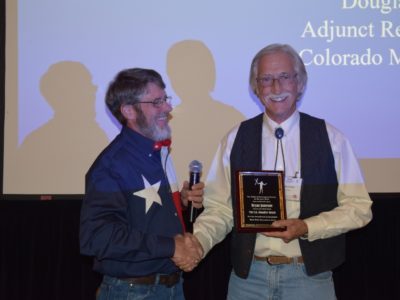
Maryland Archaeology and the Certified Archeological Technician Program

CAT Instrument Survey Workshop at Bee Tree Preserve in northern Baltimore County (photo courtesy of author via http://marylandarchaeology.org)
Citizen-scientists didn’t just dominate Maryland archaeology until the 1960s…they were Maryland archaeology. But, as in all areas of scientific endeavor, they were marginalized by a growing body of professional, university trained scientists. The Archeological Society of Maryland (ASM) reversed this trend in 2001 with the creation of the Certified Archeological Technician (CAT) program, offering individuals the opportunity to obtain recognition for formal and extended training in the goals and techniques of archeology without having to participate in an academic degree program. Now in its eleventh year, the program honors its thirteenth and fourteenth graduates: Valerie Hall and David Frederick.
ASM took several years to develop and implement the program, drawing inspiration from several programs around the USA, notably those of Arkansas, Oklahoma, and Virginia. Principal challenges that confronted the organizational committee came largely from the professional community which was very skeptical about the value and wisdom of certifying individuals who did not come through conventional university programs and that insisted on a more thorough academic grounding (largely through a lengthy reading list of regional and national classic studies) than seemed consistent with the objective of the program. Some of those fears were allayed by including representatives on the CAT committee from the Maryland Historical Trust – the state’s principal historic preservation agency and institutional seat of the state historic preservation office – and from the statewide professional organization, the Council for Maryland Archeology. These representatives participate in all discussions regarding program modification and in the “defense” of each candidate for certification.
Most members of the organizational committee brought to the table preconceptions of the purpose of the program. Agency archaeologists saw the CAT program as a training ground for prospective volunteers. Other participants thought that successful candidates might use their credentials to take jobs away from those in the private sector who completed more conventional training programs. The more skeptical professional members feared that CAT awardees would use their certification as legitimization for unscientific collecting, misrepresenting themselves to gain access to sites on private and public properties for personal gain. In the end, the committee established the current purpose of the program: to meet the needs of ASM members seeking formal archaeological training, without assuming personal motivations, and a signed ethics statement providing sufficient insurance against misrepresentation. Since Annetta Schott became the first candidate to complete the program (2003), none of these fears have been realized, and the CAT program has become non-controversial and institutionalized.
The key to the success of the CAT program and the concept that has allayed most fears lies within the program name. The ‘T’ stands for technician; not scientist. Here we modify the citizen-scientist concept in recognition that archaeology differs from most fields of scholarly endeavor in that destruction of physical evidence often is unavoidable, a circumstance not generally encountered in cataloging stars, conducting bird counts, or observing whale behavior. Candidates and graduates work under the direction of professional archaeologists engaged in the ethical study of archaeological resources, helping CAT candidates and graduates recognize the difference between ethical and unethical work.
Each candidate (aged 16 or older) applies to the program, paying a nominal one-time fee ($50) and agreeing to abide by the statement of ethics. Candidates pick or are assigned a mentor who: answers procedural questions; identifies field, laboratory, and archival research opportunities; recommends readings and provides copies of difficult to acquire publications; and serves in all other ways one might expect of a mentor. Candidates complete a course of directed reading; document in a journal as well as on a series of forms the required hours in different aspects of fieldwork (mapping, survey, excavation) and laboratory work; prepare forms for registering newly discovered sites; and participate in a series of required and optional workshops offered by professional archaeologists, including: archaeological law and ethics, overviews of state archaeology; historic and aboriginal ceramics; lithic analysis, etc. ASM’s annual field session in archaeology, conducted over eleven days each spring in partnership with the Maryland Historical Trust since 1974, provides opportunities for candidates to fulfill many requirements, but other state, county, and foundation programs, as well as some opportunities offered by the private sector, are integral to the program.
The CAT program appears to be an unqualified success, both in terms of meeting the specific personal goals of individual participants and in providing programs for ASM members who are not candidates. Presentation of awards to the two latest graduates at ASM’s annual spring symposium – which focuses this year on the archaeology of war and community conflict – publicly recognizes their achievements and inspires others to join and complete the program (current enrolment is 48 in an organization of just over 300). Producing one to two graduates each year, the CAT committee is considering other program developments, including a “Kitten” program for adolescents, an advanced level for CAT graduates, and prospective roles in future programs for graduates, most of whom remain active in ASM. The committee also has begun to work more closely with comparable programs in the neighboring states of Delaware and Virginia and encourages candidates to participate in legitimate archaeological projects outside of the state. I would like to see graduates directing field and laboratory projects under nominal professional direction, work proceeding without constant supervision. Would we realize the worst fears of the program’s early opponents? Or would we greatly expand the capacity of the professional community to explore the past? A worthwhile experiment?



